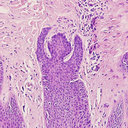Dose-dependent suppression of serum prolactin by cabergoline in hyperprolactinaemia: a placebo controlled, double blind, multicentre study. European Multicentre Cabergoline Dose-finding Study Group.
Keywords
Abstract
OBJECTIVE
Dopamine agonists have a well established place in the treatment of hyperprolactinaemic disorders but their use is associated with a high incidence of adverse effects. We have investigated the biochemical efficacy and side-effect profile of a range of doses of the novel, long-acting dopamine agonist, cabergoline, in suppressing prolactin (PRL) in hyperprolactinaemic women.
METHODS
Multicentre, prospective, randomized, placebo controlled and double blind.
METHODS
One hundred and eighty-eight women with hyperprolactinaemia secondary to microprolactinoma (n = 113), idiopathic disease (n = 67), empty sella syndrome (n = 7) or following failed surgery for a macroprolactinoma (n = 1).
METHODS
Weekly assessment of adverse symptoms, blood pressure and pulse, serum PRL, blood count, liver and renal function.
RESULTS
Patients received either placebo (n = 20) or cabergoline 0.125 (n = 43), 0.5 (n = 42), 0.75 (n = 42) or 1.0 mg (n = 41) twice weekly for 4 weeks. The five treatment groups were comparable in age (mean 31.8, range 16-46 years), diagnosis, previous therapy, and pretreatment serum PRL. PRL was suppressed to below half the pretreatment level in 5, 60, 90, 95 and 98% and normalized in 0, 30, 74, 74 and 95% of patients taking placebo or cabergoline 0.125, 0.5, 0.75 or 1.0 mg twice weekly respectively (Armitage's test, chi 2 = 39.3, P < 0.01). Cabergoline therapy (all doses) restored menses in 82% of the amenorrhoeic women not previously treated with dopamine agonists. Adverse events were recorded in 45% of patients in the placebo group and in 44, 50, 50 and 58% of those taking 0.125, 0.5, 0.75 and 1.0 mg cabergoline twice weekly (Armitage's test, P > 0.05). Over 95% of reported symptoms were relatively trivial, most frequently transient nausea, headache, dizziness, fatigue and constipation. More severe adverse events, interfering significantly with the patients' lifestyle, occurred in 13 (7.7%) patients taking cabergoline; treatment withdrawal was necessary in only one case. No adverse effects were detected on blood pressure or haematological or biochemical parameters.
CONCLUSIONS
We have shown a linear dose-response relationship for cabergoline in the treatment of hyperprolactinaemia in the range 0.125-1.0 mg twice weekly, with normalization of PRL in up to 95% of cases and acceptable tolerability throughout the dose range.


